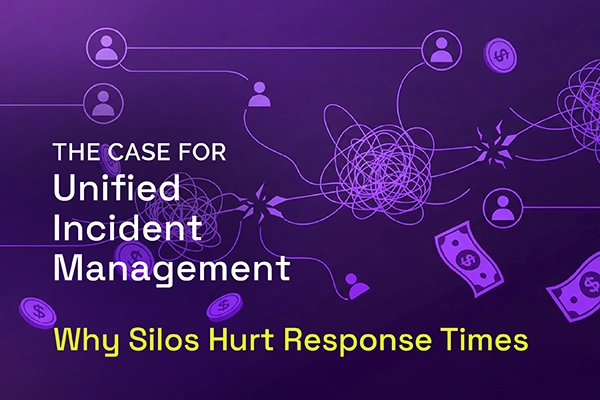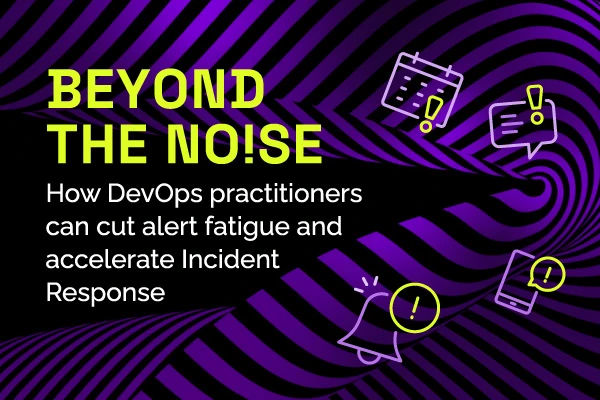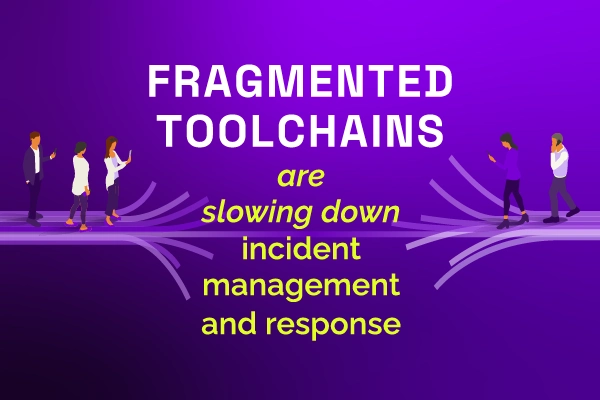The case for unified Incident Management: why silos hurt response times

$52,980
$367,800
$843,360
Those are average, per-hour costs of downtime for various incidents — server, DDoS attacks, IT Outages, respectively (multiple sources).
Major Incidents (outages, breaches) frequently range from tens of thousands to millions of dollars per incident, depending on scale and sector.
Now, imagine the cost of an incident when your team is living in a world of "fragmented chaos," as illustrated in the example here:
It's 6:47 PM on Wednesday. Your company's flagship mobile app — used by 2.3 million customers — suddenly stops processing payments during peak evening shopping hours.
Within minutes, "fragmented chaos" unfolds across multiple fronts:
Customer support receives a combined 847 calls and chats in the first 20 minutes ... but the incident tracking system shows "no known issues" because IT hasn't updated its separate platform yet.
The DevOps team discovers the database failover didn't trigger properly ... but they're working with a different monitoring tool that doesn't connect to the customer-facing status page.
The executive team joins an "emergency" conference call demanding updates ... but nobody can give them a unified view of impact, timeline, or customer communication status.
Meanwhile, a half dozen disparate Slack channels light up with finger-pointing. The status page still shows green. Customers are angrily messaging. And the person responsible for updating stakeholders is frantically copying and pasting information between five different systems.
The result: What should have been a several-minute database switch becomes a several-hour customer confidence crisis — all because incident response tools live in silos instead of working as one coordinated system.
Fragmented tools = fragmented teams = fragmented chaos
A modern enterprise requires modern service desk support, but that support fails when incident response tools live in isolation.
The current reality reveals a troubling pattern: 3 applications, 3 logins, 3 separate activities — zero integration.
1. IT Service Desk logs into one application for Service Management.
2. IT Ops uses another platform (or multiple) for monitoring and observability.
3. DevOps operates in yet another tool for incident response.
As we shared, "Departmental silos create inconsistent experiences," where each department operates independent systems with different user interfaces.
This fragmented approach creates a host of operational inefficiencies:
Context switching, where teams waste precious minutes, often during high-stress incidents, jumping between platforms to piece together what's actually happening. Updates get lost. Work is duplicated. And the cycle drags on.
An information black hole forms, resulting in critical context that scatters across silos. When a major incident occurs, teams often find themselves with critical context scattered across silos, making it nearly impossible to maintain situational awareness during emergencies.
IT bottlenecking turns into everything as "IT's problem," and IT teams get buried under non-IT service requests. As shared here, "when everything is an IT problem, IT teams become overwhelmed with non-IT service requests. And overwhelmed teams lead to a culture of finger-pointing and departmental silos."
On top of that, fragmented tools transform every major incident into an enterprise-wide fire drill. Instead of a coordinated emergency response, organizations face:
- Multiple monitoring systems, all alerting different teams simultaneously (or at different times!)
- Manual processes for impact assessment and team assembly
- Customer communication as an afterthought
- The dreaded "Doom Loop" — a cycle of reactive firefighting where teams "detect an issue, analyze it, and restore service ... only to repeat the same process when the next disruption occurs."
When Service Management lives in silos, so does productivity. What should be seamless coordination becomes chaotic scrambling, turning manageable incidents into organizational crises.
What does unified Incident Management actually mean?
Integrating tools, say, moving from 3 platforms to one, is the first step to realize true unified Incident Management. But it's just one piece of the bigger strategy.
Unified Incident Management requires 3 core components to be in place to be the most effective:
1. Intelligent detection & automation
A unified platform that ingests events from all enterprise monitoring sources in real-time, automatically assessing impact and determining required teams. Pre-configured workflows eliminate manual handoffs by routing incidents through the proper communication channels and escalation paths.
How Xurrent delivers: Our platform combines AI-powered automation that's built-in, not bolted on. Xurrent's AI goes beyond simple ticket creation — it assists teams during incidents by answering questions and automatically retrieving correct data from relevant systems in real-time.
2. Coordinated communication & stakeholder management
Customer communication happens in real-time as incidents unfold through integrated, modern status pages. Cross-functional notifications automatically reach IT and business stakeholders, customers, and executive teams. All stakeholders collaborate in shared spaces with the same information.
How Xurrent delivers: By using our status page software, customer communication happens automatically, not as an afterthought. When incidents occur, the platform immediately updates customer-facing status pages while simultaneously coordinating internal response teams. This proactive communication approach transforms "reactive chaos into proactive communication," maintaining customer trust even during disruptions.
3. Integrated resolution & continuous learning
Seamless ITSM workflows span organizational boundaries while AI-assisted documentation captures institutional knowledge from every incident. Built-in post-incident analysis drives enterprise-wide improvements, transforming reactive firefighting into proactive resilience building.
How Xurrent delivers: Our unified platform approach creates real-time synchronization between the Service Desk, IT Operations, DevOps, and stakeholders. Xurrent's AI conducts detailed root cause analysis through automated postmortems, creating what we call the "Virtuous Cycle" — a proactive, intelligence-driven approach that focuses on prevention rather than just detection and recovery.
When all three components work together seamlessly, the difference between fragmented chaos and coordinated response becomes crystal clear.
The choice is obvious: coordination > chaos
The math is undeniable. At $52,980 per hour for server incidents and $843,360 per hour for IT Outages, every second of fragmented response costs real money.
However, as we've outlined above, the actual cost isn't just financial — it's organizational trust, customer confidence, and team morale.
Every day, organizations make a choice. Continue accepting fragmented chaos as the price of doing business, or embrace unified Incident Management that transforms crisis into coordination.
With unified Incident Management, that several-hour customer confidence disaster becomes a several-minute resolved incident. The database failover triggers automatically. StatusCast updates customers immediately. Cross-functional teams coordinate seamlessly. The Doom Loop becomes the Virtuous Cycle.
Better outcomes.
Your next incident is coming. The only question is: will your response be coordinated or chaotic?
Get started with Xurrent today.
FAQs
1. What are the average per-hour costs of downtime for different types of incidents?
According to multiple sources, the average per-hour costs of downtime are $52,980 for server incidents, $367,800 for DDoS attacks, and $843,360 for IT Outages. Major ITSM incidents (outages, breaches) frequently range from tens of thousands to millions of dollars per incident, depending on scale and sector.
2. What is "fragmented chaos" in Incident Management?
Fragmented chaos occurs when incident response tools live in silos instead of working as one coordinated system. This creates a situation where teams waste precious minutes during high-stress incidents jumping between platforms to piece together what's actually happening, with updates getting lost, work being duplicated, and the cycle dragging on.
3. How do departmental silos affect incident response?
Departmental silos create inconsistent experiences where each department operates independent systems with different user interfaces. The current reality shows a troubling pattern: IT logs into one application for Service Management, HR uses another platform for Enterprise Service Management, and DevOps operates in yet another tool for incident response.
4. What operational inefficiencies are created by fragmented Incident Management tools?
Fragmented tools create context switching, where teams waste precious minutes jumping between platforms, leading to an information black hole where critical context gets scattered across silos, and IT bottlenecking, where IT teams get buried under non-IT service requests. When everything becomes "IT's problem," IT teams become overwhelmed with non-IT service requests, and overwhelmed teams lead to a culture of finger-pointing and departmental silos.
5. What is the "Doom Loop" in Incident Management?
The Doom Loop is a cycle of reactive firefighting where teams detect an issue, analyze it, contain it, eradicate it, and recover, only to repeat the same process when the next disruption occurs. This transforms every major incident into an enterprise-wide fire drill with multiple monitoring systems alerting different teams, manual processes for impact assessment, and customer communication as an afterthought.
6. What are the three core components of unified Incident Management?
Unified Incident Management requires three core components: 1) Intelligent detection & automation with a unified platform that ingests signals from all enterprise monitoring sources in real-time, 2) Coordinated communication & stakeholder management with real-time customer communication and cross-functional notifications, and 3) Integrated resolution & continuous learning with seamless ITSM workflows and AI-assisted documentation.
7. How does Xurrent deliver intelligent detection and automation?
Xurrent's platform combines AI-powered automation that's built-in, not bolted on. Xurrent's AI goes beyond simple ticket creation — it assists teams during incidents by answering questions and automatically retrieving correct data from relevant systems in real-time. Pre-configured workflows eliminate manual handoffs by routing incidents through the proper communication channels and escalation paths.
8. How does Xurrent handle customer communication during incidents?
Through StatusCast integration, customer communication happens automatically, not as an afterthought. When incidents occur, the platform immediately updates customer-facing status pages while simultaneously coordinating internal response teams. This proactive communication approach transforms "reactive chaos into proactive communication," maintaining customer trust even during disruptions.
9. What is the "Virtuous Cycle" in Incident Management?
The Virtuous Cycle is a proactive, intelligence-driven approach that focuses on prevention rather than just detection and recovery. Xurrent's unified platform approach creates real-time synchronization between the Service Desk, IT Operations, and stakeholders, with AI conducting detailed root cause analysis through automated postmortems to drive enterprise-wide improvements.
10. How does unified Incident Management transform crisis response?
With unified Incident Management, what should have been a several-minute database switch no longer becomes a several-hour customer confidence crisis. The database failover triggers automatically, StatusCast updates customers immediately, cross-functional teams coordinate seamlessly, and the Doom Loop becomes the Virtuous Cycle, transforming crisis into coordination with better outcomes.

Xurrent named a Market Leader in Research In Action’s Vendor Selection Matrix™ for IT & Enterprise Service Management Solutions
Xurrent earns #1 rankings in customer satisfaction, price vs value, and recommendation index in Research In Action's global ITSM/ESM Vendor Selection Matrix report.





